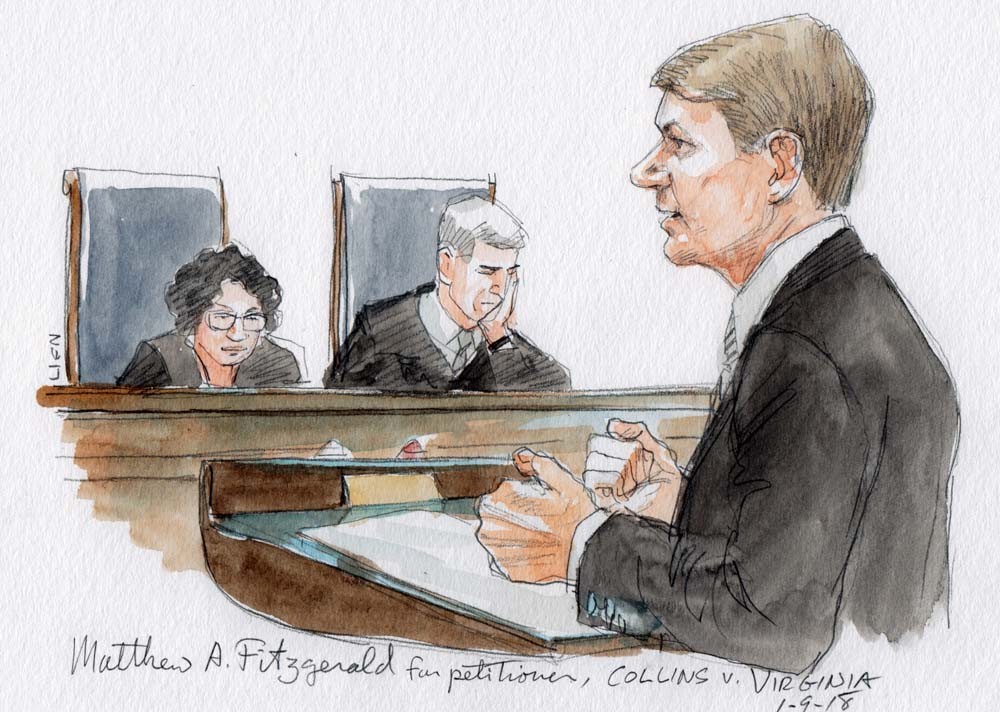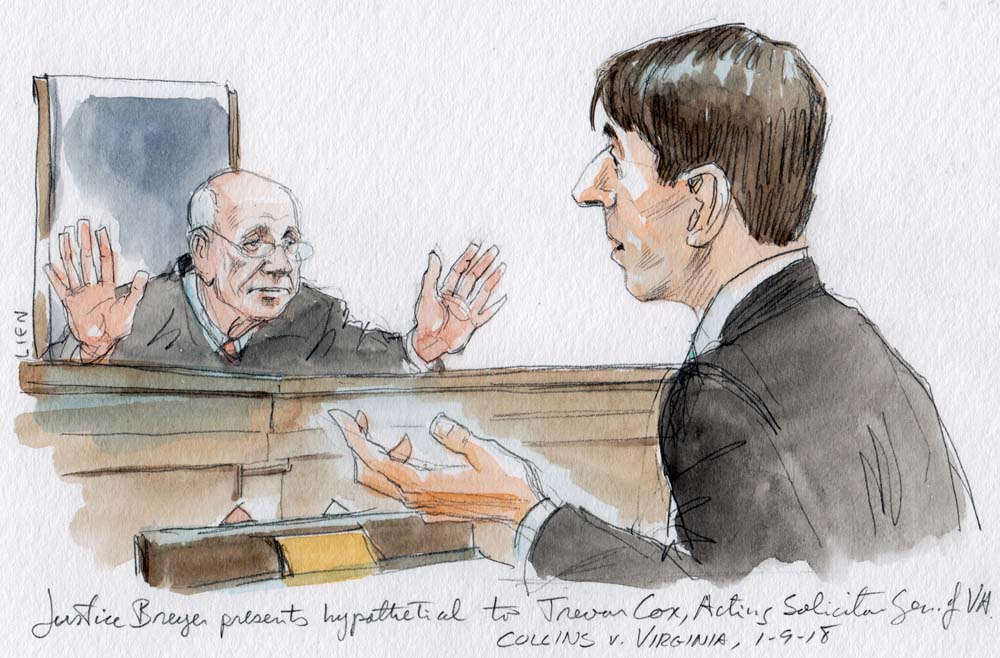Argument analysis: Trying to draw lines on vehicle searches

on Jan 10, 2018 at 10:12 am

The Supreme Court spent the first hour of oral arguments yesterday debating the Fourth Amendment, privacy rights and rental cars. The Fourth Amendment was also the focus of the second hour, when the justices heard oral argument in Collins v. Virginia. In Collins, the question before the court was the scope of the “automobile exception” to the Fourth Amendment, which allows police to search a vehicle without a warrant if the vehicle is “readily mobile” and they have probable cause to believe that it contains evidence of a crime. When the oral argument ended, the justices seemed to find the rules proposed by both sides lacking, but with the more protective rule espoused by the defendant perhaps less imperfect.
The case arose when police were looking for a motorcyclist who had eluded their efforts to stop him by driving at speeds of well over 100 miles per hour. Officers went to the home where Ryan Collins spent several nights each week and saw the motorcycle parked under a white tarp in the driveway. Lifting the tarp allowed one of the officers to see the vehicle’s license plate and vehicle identification number, which in turn enabled him to determine that the motorcycle had been stolen. At his trial for possessing stolen goods, Collins argued that the evidence regarding the motorcycle could not be used against him because the officer had violated the Constitution when he searched the motorcycle in the driveway, but the lower courts rejected that contention.
Arguing on Collins’ behalf at oral argument yesterday, attorney Matthew Fitzgerald urged the justices to rule that the “automobile exception” does not apply when a vehicle is parked in the area surrounding the home, known as the “curtilage.”

Matthew A. Fitzgerald for petitioner (Art Lien)
Justice Samuel Alito expressed doubts about Collins’ proposed rule. The automobile exception, he noted, resulted from an effort to balance two concerns: the “risk that the vehicle is going to be moved” and “the degree of intrusion on property.” But is the balance really different in Collins’ case, he asked, “than it would be if this motorcycle had been parked on the street”? “The invasion of privacy that’s involved in walking a few feet up the driveway,” he seemed to suggest, is minimal – particularly because the home was not even Collins’.
Fitzgerald stressed that the privacy accorded to the “curtilage and the home are essentially more important concerns” than those implicated by the automobile exception. He reminded the justices that police would need a warrant to go into a home to search for cocaine, even though “there’s nothing that is easier to dispose of than a fistful of cocaine.”
This argument seemed to gain some traction with Justice Neil Gorsuch. He told Trevor Cox, the acting solicitor general who argued on behalf of Virginia, that if the justices treated this case as a straightforward application of the automobile exception, “then we should just go ahead and do the same thing for drugs and papers too.” “What’s the difference,” he asked, “between the destruction of drugs and papers in a home and a car in the garage?”
Justice Sonia Sotomayor seemed to agree with Gorsuch. If there is no real difference “between opening a garage door and just walking out and getting into a car,” she said to Cox, “you’re asking us to expand the automobile exception dramatically and basically make an all-time exception forever,” whenever a car is involved. “Even if the police know that the driver of this car is away on vacation and won’t be returning for two weeks,” she queried, “they’re not required to go to a magistrate and get a warrant?”
Justice Anthony Kennedy, though, pressed Fitzgerald on whether the police could be concerned that the motorcycle could be easily moved. “So you think,” he asked, “the ease of moving” the motorcycle “is irrelevant to this case? That’s what you want us to say.”
Fitzgerald again emphasized that the motorcycle was “not any more readily mobile than things that require a warrant, such as illegal drugs.”
Another point of contention was whether and to what extent the Supreme Court’s earlier cases require the justices “to treat the curtilage exactly as we would the home.” Fitzgerald insisted that the curtilage was indeed “protected as part of the home itself,” but Alito questioned whether the court had gone that far.
For his part, Cox suggested that – at least for cases like this one – police could search vehicles within the curtilage, but not within the house itself. But some justices did not seem to like that line. Gorsuch, for example, asked Cox whether police could “search for cars in garages, closed garages, carports, anywhere on a property no matter how closely attached or even if firmly attached to the house?”

Trevor S. Cox, acting solicitor general of Virginia (Art Lien)
Justice Elena Kagan objected to Cox’s suggestion that courts could treat the curtilage differently from the home for the automobile exception, but not for reasonable expectations of privacy. She told Cox that she interpreted the court’s earlier cases “to say the home is the most sacrosanct of places. And, actually, we don’t think that the home stops at the door; we think that there are some areas like the porch and like the driveway or whatever” that “are just as sacrosanct as your living room.” “And in that case, I think you lose here.”
Chief Justice John Roberts pressed Cox on the limits of his proposed rule. If the automobile exception is premised on the idea that vehicles are mobile, he asked, what about vehicles that are actually in a house – like comedian Jay Leno’s house, “where he’s got dozens of rare cars,” or the classic Ferrari (although Roberts referred to it as a Porsche) in the film “Ferris Bueller’s Day Off”?.
Cox answered that the Supreme Court “has laid down a categorical exception. If you were to draw a line,” he told the justices, “we think the most sensible place to do it would be the bright line of the house because it is used in other Fourth Amendment jurisprudence.” But, he reminded the justices, the court wouldn’t need to decide that question if it were to rely wholly on the automobile exception.
Toward the end of Cox’s time at the lectern, Sotomayor returned to the idea that the Virginia Supreme Court’s rule was an “absolute” one, “not a balancing test.” The lower court, she emphasized, “said you can search any place where the car is.”
Cox noted that the state’s intermediate appellate court had decided the case on the ground that police needed to act quickly, because “Collins had been alerted to the police’s interest in the vehicle.” Although Virginia would “rather win on the categorical exception,” Cox acknowledged, the commonwealth also believes that it could prevail because of the exigent circumstances.
Justice Ruth Bader Ginsburg, the court’s procedure maven, pointed out that because the Virginia Supreme Court had not addressed the exigency question, the Supreme Court could not take it on. Instead, she said, the justices would have to send the case back to the state courts. Cox seemed ready to accede to a remand, but it’s not at all clear whether there are five votes for that result.
This post was originally published at Howe on the Court.


